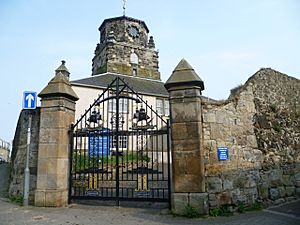Burntisland Parish Church facts for kids
Quick facts for kids Burntisland Parish Church |
|
|---|---|
 |
|
| 56°03′29″N 3°13′57″W / 56.05804°N 3.23243°W | |
| Location | Burntisland |
| Country | Scotland |
| Denomination | Church of Scotland |
| History | |
| Founded | 1592 |
| Architecture | |
| Heritage designation | Category A listed building |
| Completed | 1595 |
Burntisland Parish Church, also called St Columba's, Burntisland, is a historic church in the town of Burntisland, Scotland. It was built for the Church of Scotland in 1592. This church is very important because it was one of the first churches built in Scotland after a big change called the Reformation. It has a special square shape that was quite new for its time. Because of its unique design and history, it is considered a very important building.
In 1601, a major meeting of the General Assembly of the Church of Scotland happened at this church. At this meeting, they suggested to King James VI of Scotland that a new Bible translation should be made. When James later became King James I of England, he was able to help create what became the famous King James Version of the Bible.
History of Burntisland Church
The town of Burntisland grew a lot during the 1500s. It became a "royal burgh" in 1568, which meant it had special rights from the king. Because the town was growing and its people felt proud, they decided to build a brand new church. This new church replaced an older one that was about a mile north of Burntisland, in an area called Kirkton.
Unique Church Design
The church building is famous for its square shape. Inside, it measures about 18 meters (almost 60 feet) on each side. Four large arches reach from the corners towards the center, forming a smaller square in the middle. People have suggested that its design might have come from other countries, like the Netherlands. However, no older buildings with this exact design have been found. This means Burntisland Parish Church might have been the first of its kind in Scotland.
The church also has a special gallery, which is like a balcony, with its own exit. This was for sailors who needed to leave the church service quickly. They had to go when the ocean tide was right for their ships to sail.
The church's tower was rebuilt in 1748 by Samuel Neilson. Later, in 1822, David Vertue made big changes. He made the windows larger and removed many of the old wooden benches.
The architect Malcolm Fraser once said that the church's unique design showed "democracy and the freedom of man to communicate directly with God." Another expert, Henry Kerr, thought the church's structure had a special meaning. He said the church is built high on a rock, and its four walls lean towards the tower. This, he believed, showed the "strength and safety" of the Church.
Inside the Church: Decorations and Features
The inside of Burntisland Parish Church is decorated with beautiful carved wooden panels. Many of these carvings show things related to the town's history with the sea. You can see pictures of ships, ship owners, and people who worked in sea-related jobs.
Besides areas for sailors, there were also special sections for different groups of workers, called guilds. These included schoolmasters, tailors, metalworkers (hammermen), malt makers, and bakers. In the west gallery, there is a painted panel from 1930. It remembers the 800th anniversary of the old church at Kirkton.
The Magistrate's Pew, in the northeast corner, was built in 1606 for Robert Melville of Rossend. A "pew" is a long bench in a church. In 1907, Robert Rowand Anderson helped to fix up this pew and other parts of the church's inside. The church bell was made by Isobel Meikle in 1708. The organ, a large musical instrument, was paid for by Andrew Carnegie. He was a very rich businessman who was born in Fife, Scotland. The church was also extensively updated in the 1990s.

